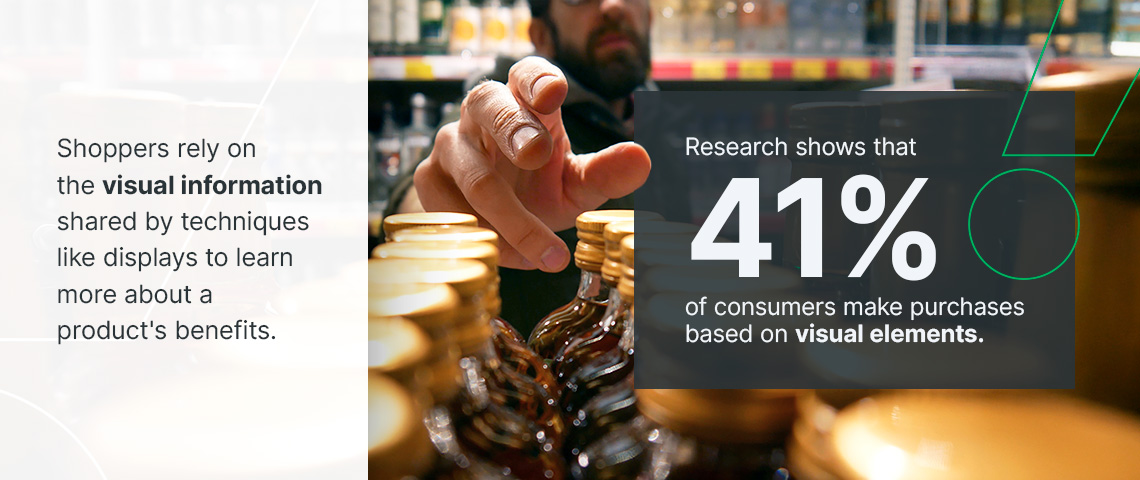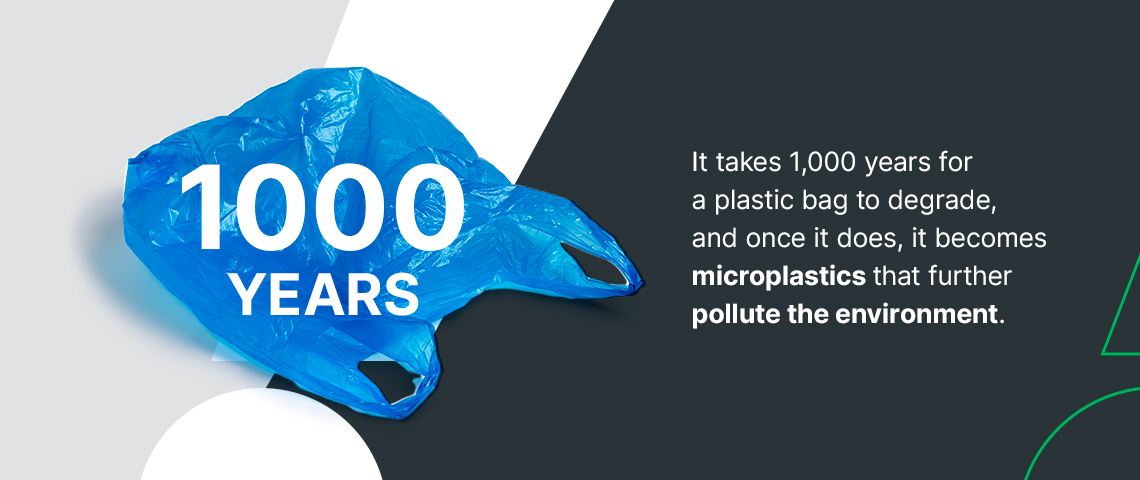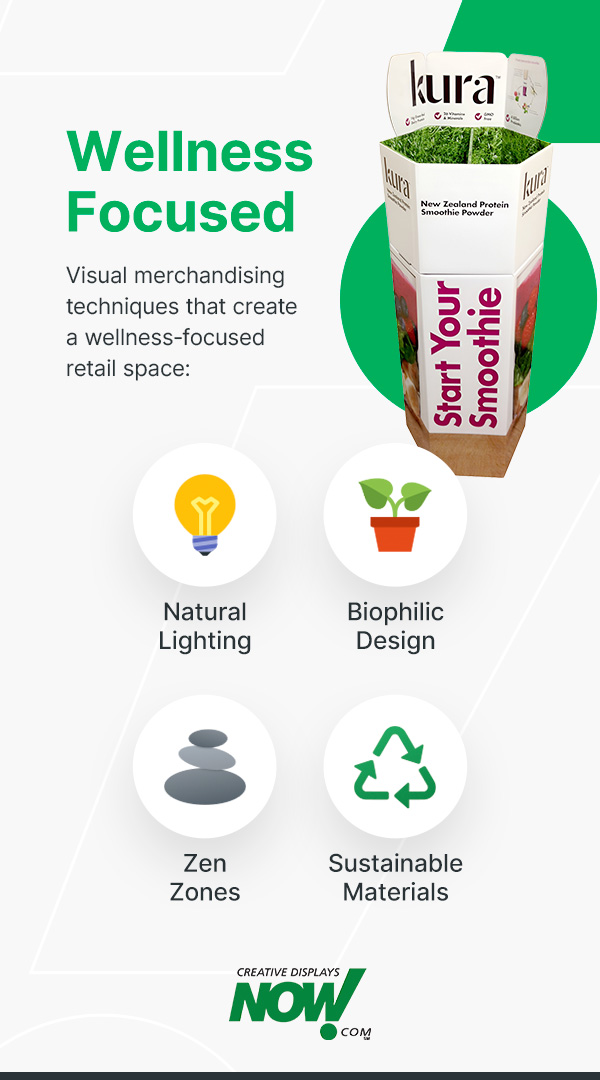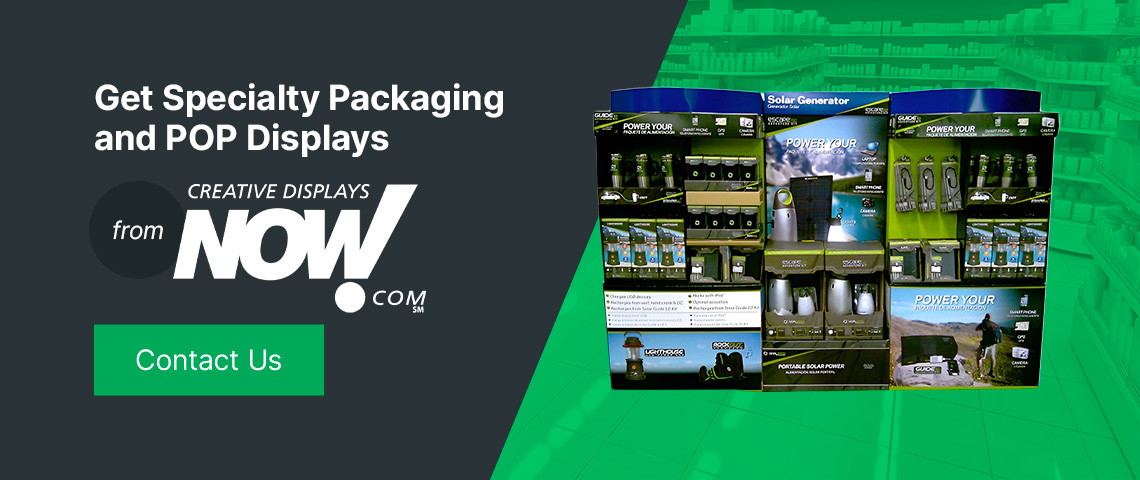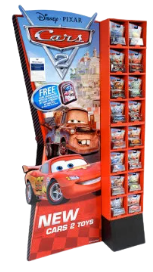Retail visual merchandising is the spirit of any store. It breathes life into the shopping experience, making it more comfortable and enjoyable for shoppers. Techniques like retail displays, cross-merchandising and signage make stores easy to navigate and persuade shoppers to purchase more.
Explore the top visual merchandising techniques for 2025 and their effect on stores’ capabilities.
What Is Visual Merchandising?
Visual merchandising is a retail technique that aims to improve product presentation and engage shoppers. It involves organizing products to persuade customers to make a purchase. Elements like lighting, displays and signage are core visual merchandising techniques that help strengthen brand identity and create a more pleasurable and immersive experience.
Effective visual merchandising is almost like having a salesperson selling and informing shoppers about different products. It’s an art form that creates enticing, stimulating shopping spaces for customers. The added stimulation can encourage customers to stay longer, leading to more purchases and a positive perspective of the shop.
Visual merchandising is not just about lighting. There are typically four elements of visual merchandising:
- Exterior: The exterior visual merchandising involves window displays, the entrance and marquees.
- Interior: The interior involves the flow, lighting, fixtures and overall design.
- Layout: The layout focuses on the different areas for selling, merchandising and personnel.
- Display: The display involves the way the merchandise is presented to shoppers.
Why Is Visual Merchandising Important?
Visual merchandising is crucial for the functioning and brand image of the store. Here are the top reasons that emphasize the importance of visual merchandising.
Aids Storytelling
Retailers use visual merchandising techniques to share their brand story with shoppers in a way that resonates with them. In the highly competitive retail industry, storytelling techniques can put a face to the brand and make it more memorable. It allows businesses to influence public perception and position themselves as the solution to various pain points.
Storytelling can also help shine a spotlight on the company’s mission and brand culture, which can increase sales. Research shows that purpose-driven brands can grow three times faster than others.
Increases Sales
Shoppers rely on the visual information shared by techniques like displays to learn more about a product’s benefits. Research shows that 41% of consumers make purchases based on visual elements.
Visual merchandising techniques like window displays can attract more consumers, increasing foot traffic in the store. Having exciting or trendy window displays also keeps the shopping experience fun for regular shoppers, which can boost loyalty.
Other visual strategies, like retail displays, can make products more appealing, highlight special promotions and encourage shoppers to make more purchases.
Boosts Product Appeal
Visual merchandising techniques like proper lighting and retail displays can help draw attention to products. They can also highlight products that are typically in low demand or help introduce new products to shoppers.
Visual merchandising combines branding, customer experience and design elements to make products look attractive and showcase their best features. Effective layouts can also encourage impulse purchases through well-positioned promotions and displays.
Enhances the Shopping Experience
Visual merchandisers are like the store’s event technicians. They use techniques like themed displays, signage, props and product promoters to turn the shopping experience into an entertaining trip. The elevated shopping experience creates positive associations with the brand and improves the store’s overall ambience.
Product display placements are also a key factor in visual merchandising since they create a psychological response in shoppers. Items placed at eye level are more likely to capture attention since customers see products at eye level first.
Provides Advertising Outlets
Promotional signage, retail displays, in-store promoters and product campaigns highlight visual merchandising’s effectiveness in advertising products to shoppers. They attract shoppers to different goods and help them form meaningful connections with brands.
Visual merchandising uses elements to help products resonate with customers’ desires, values and core beliefs. For example, using retail displays made from sustainable materials can speak to environmentally conscious consumers.
What Are the Top Visual Merchandising Techniques of 2025?
Visual merchandising will always be around, but it continues to evolve to fit the retail climate. Keeping up with the latest trends is crucial to maintaining a modern, stylish store aesthetic. From sustainability efforts to minimalist visuals, current trends bring exciting and thoughtful energy to the retail space. Here are the top visual merchandising tips to implement in 2025.
Minimalism
Minimalism will still be around in 2025 and probably for many years to come. It’s no surprise, thanks to its ability to increase visibility and create a tranquil shopping experience. It gives products the spotlight and provides clarity to shoppers.
This trend typically works for most retail stores. It boasts clear shelving and neutral shades that draw shoppers in to learn more about the products. It’s an essential component of retail visual merchandising in many boutique shops, large grocers and even beauty and fashion retailers.
Research shows customers are more interested in their health and hygiene when choosing a store. The minimalist aesthetic can help achieve a clean appearance. The key to achieving a minimalist space is remembering that less is more. Merchandisers should aim to achieve a balance between providing a functional and aesthetically pleasing shopping space.
Maximalism
While minimalism has held the spotlight for many years, there’s a new contender on the horizon. With the rise of Gen Z consumers interacting with more retail spaces, brands should consider their preference for maximalist design. This trend is especially effective for fashion and beauty retailers or those who cater mostly to younger audiences.
The maximalist style uses creative retail display ideas like bold colors, intricate patterns and unique decor elements that make the retail space stand out from competitors and give the space more personality. Interesting visual appeal can increase the time that customers spend in the store. It also sparks curiosity in products. Unlike minimalism, maximalism uses layered decorative elements, bright colors and ultra-personal features to make products stand out.
Maximalist visual merchandising elements work best for bold boutique stores that cater to a more creative or younger audience. However, creating a sense of balance is important because too many colors and designs can be overwhelming. The space still needs to be easily navigable for shoppers.
One of the best ways to achieve this balance is to create a feature wall. Another option is to keep the maximalist elements in more sociable spaces in the store, like the entrance of the waiting area.
Sustainability
Sustainability is more than a trend — it’s a lifestyle. Consumers are increasingly supportive of brands that embrace sustainable practices. Successful retailers make sustainability efforts to cater to consumers’ desires and follow respected business practices.
Research suggests that brands that actually follow sustainable practices will gain a serious advantage over those that claim to be sustainable but have not shown sufficient investment in crucial practices.
Some examples of these practices include:
- Choose products from sustainable brands: Selecting products from sustainable brands can help consumers see the business’s positive ethical standpoint. It shows that the company is serious about creating better outcomes for the environment. Sustainably focused customers might look out for these brands when deciding where to shop.
- Use recyclable packaging: Single-use plastic bags as the only option at checkout may be a turnoff for environmentally conscious shoppers. It takes 1,000 years for a plastic bag to degrade, and once it does, it becomes microplastics that further pollute the environment. Using biodegradable, recyclable or reusable bags can help a brand stick to its sustainability promise.
- Incentivize recycling: Initiatives like taking pre-loved clothes to a shop for store credit or a chance to win a prize are excellent for bringing more customer support. Creating programs for shoppers to participate in sustainability drives can create a space for environmentally conscious customers to come together. It allows them to make a difference in environmental preservation.
Community-Centric
Retailers in close-knit communities can bring everyone together by incorporating local elements in their visual merchandising strategy. Community-centric visual merchandising aims to tell the story of the local community and help build connections around special events. These elements make customers feel a sense of belonging and show that the company cares about the community. They also encourage customers to feel like they’re a part of the brand’s identity.
Here are some examples of community-centric visual merchandising strategies:
- Local artist spotlight: Collaborate with local artists to set up enticing window displays and in-store art that resonates with shoppers.
- Community walls: Set up community walls with pictures of key community members and memories from recent events. Invite local businesses to advertise near these spaces.
- Pop-ups: Create pop-up spaces featuring local artists or community favorite foods, bringing everyone together.
- Educational spaces: Build spaces dedicated to educating community members on local initiatives, charity drives and store contributions.
- Recycling centers: Set up an area dedicated to recycling and showcase community recycling initiatives spearheaded by the store.
Wellness-Focused
Consumers are becoming more health-conscious overall. From Gen Z prioritizing healthy food choices to millennials choosing sustainable and comfortable clothing over trendy options, companies need to cater to these preferences. Retail environments incorporating wellness elements of visual merchandising can help improve customer satisfaction and resonate better with these demographics’ inclination toward healthier options.
Here are some examples of visual merchandising techniques that create a wellness-focused retail space:
- Natural lighting: Large windows and outdoor shopping areas are excellent ways to encourage shoppers to enjoy the benefits of natural light while shopping.
- Biophilic design: Biophilic design uses natural elements like plants, living walls and materials like wood. These features improve the aesthetic and create a more calming environment.
- Zen zones: Create spaces where shoppers can destress and escape the busyness. Build comfortable seating areas for customers to rest and relax. Another option is to rent out a space to a cafe with healthy food to give shoppers a chance to pause and enjoy a meal.
- Sustainable materials: Retailers can use sustainable materials and practices to reflect their commitment to wellness and sustaining a healthy environment for future generations.
Store Atmospherics
Visual merchandising and store atmospherics have evolved as crossover domains in the retail sphere. Atmospherics can enhance the environment to encourage shoppers to spend more money and have a more enjoyable experience. It uses ambient sound, store fixtures and furniture to make the space more appealing.
Many visual merchandising techniques, such as floor plan strategy, intertwine with atmospherics, but atmospherics is more concerned with how the space feels than how it’s organized. Visual merchandisers should adopt atmospheric methods to create an area more welcoming to the target demographic. These methods work particularly well for stores that sell home products and furniture because they can show customers what their space may look like if they purchase those products.
Here are some of the top ways to enhance store atmospherics through visual merchandising techniques:
- Scent diffusion systems add to the ambience of different spaces. For example, vanilla scents are used in the baked goods section and luxury scents are used in the high-fashion section.
- Specially curated music can add to the sensory stimulation of a space. It helps cultivate an ambience that creates more harmony in the area.
- Color blocking by different aisle themes can help create clear separations between areas, providing a more navigable and exciting shopping experience.
- Telling stories through window displays is especially popular during festive seasons. It shows imagery that resonates with shoppers and can create a heartwarming effect.
The Best Tips for Effective Retail Visual Merchandising
Visual merchandising is about creating a retail space that keeps shoppers excited, comfortable and satisfied. Here’s how to merchandise a store with the most effective techniques:
- Use window displays: Window displays are undoubtedly one of the most effective ways to bring more customers into the store. Use them to advertise hot promotions and festive specials to really draw people in.
- Implement directional signage: Directional signage should highlight the key areas of the store, like the customer service desk or relaxation zone, to help direct shoppers to spaces without causing frustration.
- Change themes regularly: Regularly updating the store’s aesthetic prevents shoppers from becoming bored and keeps the shopping experience exciting. Fresh updates give shoppers something to look forward to.
- Stir visual engagement: It’s important to keep things visually exciting and attract shoppers through visual cues. Merchandising techniques like mannequins can help boost engagement and attract customers to potential purchases.
- Use retail displays: Retail displays paired with cross-merchandising are an effective way to attract shoppers to promotional items and make it easier to identify items they need. Retail displays encourage customers to make more purchases and increase store excitement.
Get Specialty Packaging and POP Displays From Creative Displays Now!
Take your visual merchandising efforts to the next level with custom packaging and retail display stands from Creative Displays Now. With over 60 years in business, we are experts in creating displays, packaging and signage to attract customers and make shopping exciting. Our temporary displays are made from corrugated cardboard, which can help companies stick to their sustainability promises.
Our in-house team of over 60 retail display experts can help build packaging and displays that encourage customers to make purchases and fit the structural layout of major retailers. We can design, manufacture and distribute displays like endcap, POP, multi-tiered and pallet displays. We also create packaging like promotional, merchandise and mailer boxes.
Contact us to learn how we can help you meet your retail product display and packaging needs.


